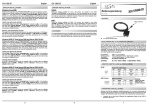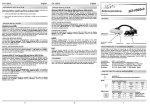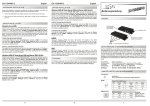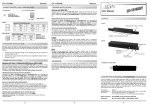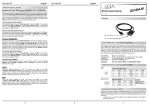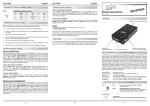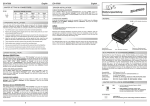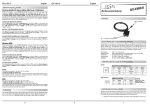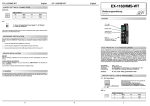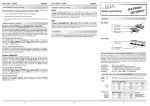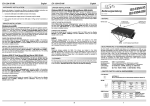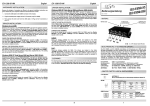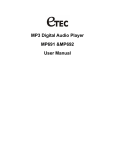Download EXSYS USB 1.1 - 1S Serial RS-232 port
Transcript
5 If you like to change the port number for example COM 3 to COM5, open the >Device Manager< click at >COM3<, >Settings< and then >Advance<. There you can change between COM 3 to 256. CHANGE PORT NUMBER: Click at Start<>Run< then enter “compmgmt.msc“ and click at >OK<. In the windows that open select >Device Manager<. Under ”Ports (COM and LPT)“ you should find one more new „USB Serial Port„ as sample (COM3). If you see this or similar entries the module is installed correctly. CHECK THE INSTALLED DRIVER: Windows will recognize a new “FT232R USB UART“ and open the hardware assistant. Please choose manual installation and put the driver CD into your CD-Rom drive (as sample D: ). Now enter the Path “D:\USB_to_IO\FTDI\Win2003_XP_VISTA(x64)” into the box for the Path/Source and click at >next/continue<. Now Windows search for the drivers in the specified directory. Follow the hardware assistant and finish the installation. If Windows recognizes other new devices repeat the above described steps. Attention! Restart Windows in any case after installing the drivers. Windows 2000 XP Vista Server 2000 and Server 2003 (64-bit): If you like to change the port number for example COM 3 to COM5, open the >Device Manager< click at >COM3<, >Settings< and then >Advance<. There you can change between COM 3 to 256. CHANGE PORT NUMBER: Click at Start<>Run< then enter “compmgmt.msc“ and click at >OK<. In the windows that open select >Device Manager<. Under ”Ports (COM and LPT)“ you should find one more new „USB Serial Port„ as sample (COM3). If you see this or similar entries the module is installed correctly. CHECK THE INSTALLED DRIVER: Windows will recognize a new “FT232R USB UART“ and open the hardware assistant. Please choose manual installation and put the driver CD into your CD-Rom drive (as sample D: ) . Now enter the Path “D:\USB_to_IO\FTDI\Win2000_2003_XP_VISTA” into the box for the Path/Source and click at >next/continue<. Now Windows search for the drivers in the specified directory. Follow the hardware assistant and finish the installation. If Windows recognizes other new devices repeat the above described steps. Attention! Restart Windows in any case after installing the drivers. Windows 2000 XP Vista Server 2000 and Server 2003 (32-bit): The speed from the serial ports can be set to the maximum baud rate of 115.2Kbaud. With double click select for example >Device manager< > USB Serial Port (COM5)<. Now you can select the different settings of baud rate, stop/start-bits etc. This setting you can use also for the other COM ports. INSTALL THE PERIPHERAL DEVICE: Click at Start<>Run< then enter “compmgmt.msc“ and click at >OK<. In the windows that open select >Device Manager<. Under ”Ports (COM and LPT)“ you should find one more new „USB Serial Port„ as sample (COM5). If you see this or similar entries the module is installed correctly. CHECK THE INSTALLED DRIVER: There are drivers available for Linux. The drivers are located in the folder “D:\USB_to_IO\FTDI\Linux“ on the driver CD. They are supported by the most versions of Linux. Because each individual distribution and kernel version of Linux is different, sadly we cant provide a installation instruction. Please refer to the installation manual for standard IO ports from your Linux version ! Windows will recognize a new “FT232R USB UART“ and open the hardware assistant. Please choose manual installation and put the driver CD into your CD-Rom drive ( as sample D: ) . Now enter the Path “D:\USB_to_IO\FTDI\Win2000_2003_XP_VISTA” into the box for the Path/Source and click at >next/continue<. Now Windows search for the drivers in the specified directory. Follow the hardware assistant and finish the installation. If Windows recognizes other new devices repeat the above described steps. Attention! Restart Windows in any case after installing the drivers. 6 For cleaning please use only a dry fluff less cloth and remove the dirt with gently pressure. In the area of the connectors please make sure that no fibres from the cloth remain in the connectors. Attention! Never use a moist or wet cloth for cleaning! CLEANING : There are drivers available for MAC. The drivers are located in the folder “D:\USB_to_IO\FTDI\“ on the driver CD. They are supported by the most versions of MAC OS. Because each individual version of MAC OS is different, sadly we cant provide a installation instruction. Please refer to the installation manual for standard IO ports from your MAC OS version ! MAC: DRIVER INSTALLATION : English LINUX: EX 1301--2 EX--1301 DRIVER INSTALLATION : English Windows 9.x and ME: EX 1301--2 EX--1301 9 Pin Stecker Seriell RS-232 USB A–Anschluss CE / FCC / RoHS / WEEE Zertifikate: CDC RXD TXD 1 2 3 Signal VCC DATA- Pin 1 2 USB 2.0 A-Buchse: Signal Pin GND DATA+ Signal DSR GROUND DTR Signal RI CTS RTS Signal Achtung! Stecker nie umgekehrt oder mit Gewalt einstecken. 9 8 7 Pin 1. 1 Verbinden sie nur das Ende (A-Stecker) des mitgelieferten Kabels mit der USB ABuchse an ihrem PC. Beachten Sie bitte die folgenden Installationshinweise. Da es grosse Unterschiede bei Computern gibt, können wir Ihnen nur eine generelle Anleitung zum Einbau der EX-1301-2 geben. Bei Unklarheiten halten Sie sich bitte an die Bedienungsanleitung Ihres Computersystems. 4 3 Pin 6 5 4 Pin Seriell 9 Pin D-SUB Stecker: HARDWARE INSTALLATION : USB A Buchse: DB 9M: JUMPER EINSTELLUNG & ANSCHLÜSSE: DE97424562 / WHQL USB 1.1 & 2.0 Anschluss WIN 9.x/ME/2000/XP/Server 2003/Vista/Linux/MAC 1 x 9 Pin Sub-D Stecker, 1 x USB A-Buchse EX-1301-2, Anleitung, CD, Kompatibilität: Betriebssysteme: Anschlüsse: Lieferumfang: Die EX-1301-2 ist ein Modul zur Umsetzung von USB auf eine RS-232 Schnittstelle mit FIFO 16C550 Ports für den Anschluss von High Speed Seriellen RS-232 Peripherie Geräten (z.B. Modem, Plotter usw.) Das USB Modul ist Hot Plug & Play fähig. Für die Einstellungen der I/O Adressen und Interrupts sind keine Jumper und Einstellungen notwendig. Sie werden vom System BIOS und beim Installieren des Betriebssystems automatisch vorgenommen. BESCHREIBUNG & TECHNISCHE DATEN : S1 AUFBAU : Vers. 1.0 / 30.06.08 Bedienungsanleitung REINIGUNG : Windows 2000 XP Vista Server 2000 und Server 2003 (32-bit): 2 Die Seriellen Ports, der USB Module können nun auf die Maximale Baudrate von 115.2Kbaud eingestellt werden. Zum Beispiel mit Doppelklick den >USB Serial Port (COM3)< öffnen. Nun können Sie die verschieden Angaben wie z.B. Baudrate, Stoppbits usw. eintragen. Die Baudrate darf nicht über 115'200 Baud eingestellt werden. Die gleichen Einstellungen können auch für die restlichen COM Ports eingestellt werden. INSTALLATION DER PERIPHERIEGERÄTE: Klicken Sie auf Start< >Ausführen< geben sie “compmgmt.msc“ ein und klicken sie auf >OK<. Wählen sie nun >GeräteManager<. Dort müssten Sie unter „Anschlüsse (COM und LPT)“ neue Einträge „USB Serial Port (COM5) bis (COM8)“ und unter „Universeller Serieller Bus Controller“ den Eintrag „USB Serial Converter“ sehen. Wenn Sie diese oder ähnliche Einträge sehen, sind die USB Module korrekt installiert. ÜBERPRÜFEN DES INSTALLIERTEN TREIBER: Windows findet einen neuen “FT232R USB UART“. Legen Sie die Treiber CD in Ihr CD -ROM Laufwerk ein (z.B. Laufwerk D:). Lassen sie nicht automatisch nach dem Treiber suchen. Geben sie “D:\USB_to_IO\FTDI\Win2003_XP_VISTA(x64)” in das Feld “Quelldatei Pfad etc.“ ein. Windows 2000 XP Vista Server 2000 und Server 2003 (64-bit): Hier können sie die Ports ändern, klicken sie z.B. auf >COM3< >Anschlusseinstellung< und >Erweitert<. Sie können dann zwischen COM3 und 256 wählen! ÄNDERN DER COM ADRESSE: Die Seriellen Ports, der USB Module können nun auf die Maximale Baudrate von 115.2Kbaud eingestellt werden. Zum Beispiel mit Doppelklick den >USB Serial Port (COM3)< öffnen. Nun können Sie die verschieden Angaben wie z.B. Baudrate, Stoppbits usw. eintragen. Die Baudrate darf nicht über 115'200 Baud eingestellt werden. Die gleichen Einstellungen können auch für die restlichen COM Ports eingestellt werden. INSTALLATION DER PERIPHERIEGERÄTE: Klicken Sie auf Start< >Ausführen< geben sie “compmgmt.msc“ ein und klicken sie auf >OK<. Wählen sie nun >GeräteManager<. Dort müssten Sie unter „Anschlüsse (COM und LPT)“ neue Einträge „USB Serial Port (COM5) bis (COM8)“ und unter „Universeller Serieller Bus Controller“ den Eintrag „USB Serial Converter“ sehen. Wenn Sie diese oder ähnliche Einträge sehen, sind die USB Module korrekt installiert. ÜBERPRÜFEN DES INSTALLIERTEN TREIBER: 3 Zur Reinigung des Gerätes verwenden sie bitte ausschliesslich ein trockenes nicht faserndes Tuch und entfernen sie die Verschmutzung mit leichtem Druck. Im Bereich der Anschlüsse bitte darauf Achten dass keine Fasern des Tuchs in der Buchse verbleiben. Verwenden sie zu Reinigung in keinem Fall ein feuchtes oder nasses Tuch! Es gibt für diese Karte MAC Treiber. Die Treiber befinden sich im Verzeichnis “D:\USB_to_IO\FTDI\“ auf der Treiber CD. Sie werden unter den meisten MAC OS Versionen unterstützt. Da sich die einzelnen Versionen von einander unterscheiden können wir ihnen leider hier keine Installationsanweisung geben. Bitte halten sie sich an die Installationsanweisung für Standard IO Ports ihrer MAC OS Version. Windows findet einen neuen “FT232R USB UART“. Legen Sie die Treiber CD in Ihr CD -ROM Laufwerk ein (z.B. Laufwerk D:). Lassen sie nicht automatisch nach dem Treiber suchen. Geben sie “D:\USB_to_IO\FTDI\Win2000_2003_XP_VISTA” in das Feld “Quelldatei Pfad etc.“ ein. MAC: Die Seriellen Ports, der USB Module können nun auf die Maximale Baudrate von 115.2Kbaud eingestellt werden. Zum Beispiel mit Doppelklick den >USB Serial Port (COM3)< öffnen. Nun können Sie die verschieden Angaben wie z.B. Baudrate, Stoppbits usw. eintragen. Die Baudrate darf nicht über 115'200 Baud eingestellt werden. Die gleichen Einstellungen können auch für die restlichen COM Ports eingestellt werden. Es gibt für diese Karte Linux Treiber. Die Treiber befinden sich im Verzeichnis “D:\USB_to_IO\FTDI\Linux“ auf der Treiber CD. Sie werden unter den meisten Linux Versionen unterstützt. Da sich die einzelnen Distributionen und Kernelversionen sehr von einander unterscheiden können wir ihnen leider hier keine Installationsanweisung geben. Bitte halten sie sich an die Installationsanweisung für Standard IO Ports ihrer Linux Version. INSTALLATION DER PERIPHERIEGERÄTE: Klicken Sie auf Start< >Ausführen< geben sie “compmgmt.msc“ ein und klicken sie auf >OK<. Wählen sie nun >GeräteManager<. Dort müssten Sie unter „Anschlüsse (COM und LPT)“ neue Einträge „USB Serial Port (COM5) bis (COM8)“ und unter „Universeller Serieller Bus Controller“ den Eintrag „USB Serial Converter“ sehen. Wenn Sie diese oder ähnliche Einträge sehen, sind die USB Module korrekt installiert. LINUX: Hier können sie die Ports ändern, klicken sie z.B. auf >COM3< >Anschlusseinstellung< und >Erweitert<. Sie können dann zwischen COM3 und 256 wählen! Windows 9.x oder ME erkennt automatisch einen neuen „FT232R USB UART“. Legen Sie die Treiber CD in Ihr CD-ROM Laufwerk ein (z.B. Laufwerk D:). Lassen sie nicht automatisch nach dem Treiber suchen. Sondern geben sie folgenden Pfad in das Feld “Quelldatei Pfad etc.“ ein. Die Treiber liegen in dem Verzeichnis "D:\USB_to_IO\FTDI\WIN98_ME”. ÜBERPRÜFEN DES INSTALLIERTEN TREIBERS: TREIBER INSTALLATION : Deutsch ÄNDERN DER COM ADRESSE: EX 1301--2 EX--1301 TREIBER INSTALLATION : Deutsch Windows 9.x und ME: EX 1301--2 EX--1301 9 Pin Serial RS-232 connector USB A–Port CE / FCC / RoHS / WEEE CDC RXD TXD 1 2 3 DATADATA+ 3 VCC Signal 2 1 Pin USB 2.0 A-connector: Signal Pin GND Signal DSR GROUND DTR RI CTS RTS Signal Attention! Never plug in with force or in wrong direction. 9 8 7 Pin 4 1. Connect the end from the USB cable ( A-Plug ) to the USB A-connector at your PC. Because the designs of computers are different, only general installation instructions are given. Please refer your computer’s reference manual whenever in doubt. 4 Pin 6 5 4 Pin Serial 9 Pin male connector: HARDWARE INSTALLATION : USB A-Connector: DB 9M: Signal DE97424562 / WHQL USB 1.1 & USB 2.0 WIN 9.x/ME/2000/XP/Server 2003/Vista/Linux/MAC 9Pin RS232 connector, 1 x USB A-Port EX-1301-2, manual, CD JUMPER SETTING & CONNECTORS: Certificates: Compatibility: Operating system: Connectors: Extent of delivery: The EX-1301-2 is a plug & play high-speed USB to Serial module for USB 1.1 and 2.0 ports with one RS232 9Pin connector. The USB to Serial modules design utilizes the Chip-Set FTDI with 16C550 UART which incorporates the latest in high speed interface technology. It is not possible to change the address or IRQ settings manually, they will be obtained automatically by the system (BIOS) and operating system. DESCRIPTION & TECNICAL INFORMATION : S1 LAYOUT : Vers. 1.0 / 30.06.08 User Manual
This document in other languages


